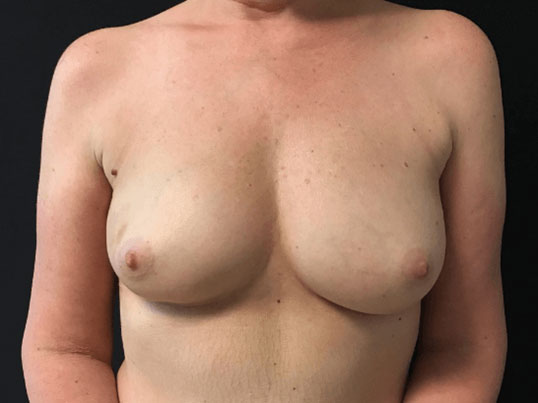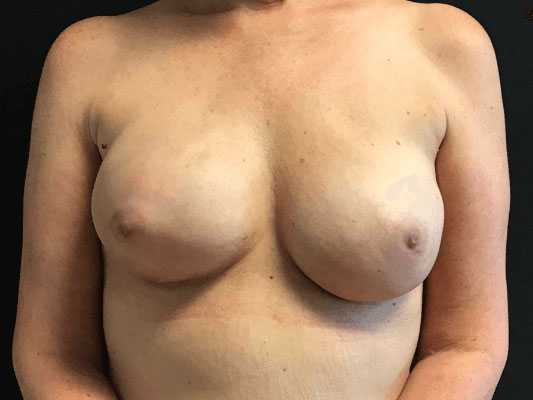Breast Reconstruction Overview
Specializing in DIEP-Flap breast reconstruction surgery, plastic surgeon Dr. Timothy Mountcastle in Northern Virginia is a trusted physician who tailors breast reconstruction surgery to beautifully restore and reshape the breasts following a mastectomy.
Many breast cancer patients will effectively undergo breast removal surgery as part of their cancer treatment, then they will have cosmetic surgery in the recovery process. Today, it is common for cancer surgeons and plastic surgeons to work together to treat cancer and restore a woman’s physical appearance for best results in patient-centered care.
Breast Reconstruction Before and After*
See More ResultsThings to Consider
During your first consultation to discuss reconstruction surgery, it is important to disclose where you are in the treatment process and which cancer surgeon is treating you, as well as provide any necessary pathology reports. The reconstruction process may take place in multiple steps if the breast tissue needs to be stretched to make room for implants. This discovery phase will help guide the reconstruction process so patients end up with a new breast that is the size, shape, and look they want.
Surgical Technique
Each reconstruction technique will be tailored according to the patient’s physical health, aesthetic goals, and personal preferences. There are many factors playing into the approach that will be taken. The ultimate goal is to ensure the patient is healthy and happy with their final breast results.
There are two primary categories of breast reconstruction techniques:
Procedures that involve using a breast implant
Procedures that are autologous (use the patient’s own body’s tissue to reconstruct and recreate the breast)
RECONSTRUCTION WITH IMPLANTS
Breast reconstruction using silicone or saline implants is a common approach that generally starts with the use of a tissue expander to help form a suitable pocket for an implant. The expander may be inserted after the mastectomy procedure or during the same operative session. Over the course of several months, the expander will slowly be enlarged using a sterile solution injected through a port residing under the skin. During the scheduled reconstruction surgery, the expanders are removed and replaced with permanent implants.
AUTOLOGOUS RECONSTRUCTION
If there is limited tissue inside the breast or limited skin on the outside, tissue may be used from another part of the patient’s body to supplement this loss. The most common areas to support this process are the buttocks, thigh, or abdomen. This is an autologous approach to breast reconstruction. The TRAM flap (Transverse Rectus Abdominus Myocutaneous), the DIEP flap and SIEA flap techniques involve taking skin and fat from the abdomen and relocating it to the breast. The Latissimus Dorsi Flap is another common method using tissue from the patient’s back.
NIPPLE/AREOLA RESTORATION
During a mastectomy, the nipple and areola often cannot be saved. The loss of one’s nipple and areola can be as unnerving as the removal of the breast itself. However, reconstruction techniques have advanced greatly, allowing plastic surgeons the opportunity to recreate these areas of the breast to give a natural, aesthetically appealing appearance. In a separate procedure, the nipple is created using existing breast skin or from the abdominal or latissimus flap. Using a tattoo technique, the areola is recreated with a skin graft taken from the thigh, abdomen, or back.
During/After Surgery
Breast reconstruction surgery is performed under general anesthesia at an accredited surgical facility. Some patients may be required to stay in the hospital to be monitored for complications. Patients who have had reconstruction using a flap technique will usually be required to stay in the hospital for 2-5 days. The recovery process can be somewhat lengthy, but many view it as the final step in their cancer journey thus the experience can be very rewarding. Most women are thankful to have had the opportunity to restore their breasts and are satisfied with their results.
Breast Reconstruction FAQs
How do I determine a qualified breast reconstruction surgeon?
This is a very specialized surgery that requires extensive knowledge, skill, and experience. It is very important to research and find a qualified and reputable plastic surgeon who has experience with breast reconstruction surgery.
Can breast reconstruction surgery be delayed?
In many situations, it is recommended to start the reconstruction process at the same time as the mastectomy. Therefore, it is a good idea to have your breast cancer surgeon and your plastic surgeon begin communicating about the steps that will follow. An advantage of doing the procedure immediately is waking up from your mastectomy surgery with the reconstruction process in place. The soft tissue that surrounds the breast will heal simultaneously with the reconstruction, which can enhance the final results.
Will I lose sensation in my breasts after reconstruction?
A reconstructed breast will not have the same sensation as the breast did before the mastectomy. However, over time, some of this sensation will return to normal. This will depend on the extent of the reconstruction process and will vary by patient.
Financing Available
Financing InfoRequest An Appointment
Contact Us
